Application of Polyethylene Glycol-Based Flame-Retardant Phase Change Materials in the Thermal Management of Lithium-Ion Batteries
Abstract
:1. Introduction
2. Material Preparation and Experiment
2.1. Materials
2.2. Preparation of Barium Phytate
2.3. Preparation of Flame Retardant CPCMs
2.4. Performance Testing and Characterization of RPCM
2.5. Experimental Setup
3. Results and Discussions
3.1. Microscopic Characterization and Thermophysical Properties
3.2. Thermal Stability, Quality Stability, and Vertical Combustion
3.3. Battery Module Heat Dissipation Performance
3.3.1. Cell
3.3.2. Battery Module
4. Conclusions
- (1)
- After the addition of MWCNTs and EG, the material exhibits a significant increase of 558% in thermal conductivity compared to pure PEG. The addition of CS/APP/PA-Ba flame retardants significantly increased the residual carbon content and flame retardancy of the material while reducing organic leakage, effectively enhancing the thermal stability of PCM.
- (2)
- When the flame-retardant content was 15%, the material RPCM2 achieved a V-0 flame retardant rating, with a thermal conductivity of 2.04 W/m·K and a latent heat value of 151.58 W/g. Therefore, RPCM2 not only maintains excellent thermodynamic performance but also exhibits outstanding flame retardancy and good thermal stability.
- (3)
- Compared to natural cooling, the use of the novel RPCM as a heat dissipation medium in thermal management demonstrated a significant cooling effect. In a 3C cycle, the battery module experienced a reduction of 18.71 °C in its maximum temperature, and the temperature difference decreased by 62.7% compared to natural cooling.
Author Contributions
Funding
Institutional Review Board Statement
Data Availability Statement
Conflicts of Interest
Nomenclature
| AlN | Aluminium nitride |
| APP | Ammonium polyphosphate |
| BN | Boron nitride |
| BTMS | Battery thermal management system |
| CPCM | Composite phase change material |
| CNTs | Carbon nanotubes |
| CS | Chitosan |
| DSC | Differential scanning calorimeter |
| EG | Expanded graphite |
| HNTs | Halloysite nanotubes |
| IFRs | Intumescent flame retardants |
| LIBs | Lithium-ion batteries |
| PA | Phytic acid |
| PA-Ba | Barium phytate |
| PA-Ni | Nickel phytate |
| PCM | Phase change materials |
| PEG | Polyethylene glycol |
| PLA | Polylactic acid |
| RP | Rad phosphorus |
| RPCM | Flame-retardant phase change material |
| SBS | Styrene-butadiene-styrene |
| SEM | Scanning electron microscopy |
| SWCNT | Single-walled carbon nanotubes |
| TGA | Thermogravimetric analyzer |
| MWCNTs | Multi-walled Carbon Nanotubes |
| XRD | X-ray diffractometer |
References
- Höök, M.; Tang, X. Depletion of fossil fuels and anthropogenic climate change—A review. Energy Policy 2013, 52, 797–809. [Google Scholar] [CrossRef]
- Kausthubharam; Koorata, P.K.; Panchal, S.; Fraser, R.; Fowler, M. Combined influence of concentration-dependent properties, local deformation and boundary confinement on the migration of Li-ions in low-expansion electrode particle during lithiation. J. Energy Storage 2022, 52, 104908. [Google Scholar] [CrossRef]
- Lv, Y.; Yang, X.; Zhang, G.; Li, X. Experimental research on the effective heating strategies for a phase change material based power battery module. Int. J. Heat Mass Transf. 2019, 128, 392–400. [Google Scholar] [CrossRef]
- Hoekstra, A. The Underestimated Potential of Battery Electric Vehicles to Reduce Emissions. Joule 2019, 3, 1412–1414. [Google Scholar] [CrossRef]
- Huang, Z.; Xu, F.; Yang, F. State of health prediction of lithium-ion batteries based on autoregression with exogenous variables model. Energy 2023, 262, 125497. [Google Scholar] [CrossRef]
- Li, M.; Dong, C.; Xiong, B.; Mu, Y.; Yu, X.; Xiao, Q.; Jia, H. STTEWS: A sequential-transformer thermal early warning system for lithium-ion battery safety. Appl. Energy 2022, 328, 119965. [Google Scholar] [CrossRef]
- Zeng, Y.; Chalise, D.; Lubner, S.D.; Kaur, S.; Prasher, R.S. A review of thermal physics and management inside lithium-ion batteries for high energy density and fast charging. Energy Storage Mater. 2021, 41, 264–288. [Google Scholar] [CrossRef]
- Held, M.; Tuchschmid, M.; Zennegg, M.; Figi, R.; Schreiner, C.; Mellert, L.D.; Welte, U.; Kompatscher, M.; Hermann, M.; Nachef, L. Thermal runaway and fire of electric vehicle lithium-ion battery and contamination of infrastructure facility. Renew. Sustain. Energy Rev. 2022, 165, 112474. [Google Scholar] [CrossRef]
- Liu, H.; Ahmad, S.; Shi, Y.; Zhao, J. A parametric study of a hybrid battery thermal management system that couples PCM/copper foam composite with helical liquid channel cooling. Energy 2021, 231, 120869. [Google Scholar] [CrossRef]
- Verma, A.; Shashidhara, S.; Rakshit, D. A comparative study on battery thermal management using phase change material (PCM). Therm. Sci. Eng. Prog. 2019, 11, 74–83. [Google Scholar] [CrossRef]
- Liu, H.; Wei, Z.; He, W.; Zhao, J. Thermal issues about Li-ion batteries and recent progress in battery thermal management systems: A review. Energy Convers. Manag. 2017, 150, 304–330. [Google Scholar] [CrossRef]
- Su, S.; Li, W.; Li, Y.; Garg, A.; Gao, L.; Zhou, Q. Multi-objective design optimization of battery thermal management system for electric vehicles. Appl. Therm. Eng. 2021, 196, 117235. [Google Scholar] [CrossRef]
- Lv, Y.; Liu, G.; Zhang, G.; Yang, X. A novel thermal management structure using serpentine phase change material coupled with forced air convection for cylindrical battery modules. J. Power Sources 2020, 468, 228398. [Google Scholar] [CrossRef]
- Wang, Y.; Liu, B.; Han, P.; Hao, C.; Li, S.; You, Z.; Wang, M. Optimization of an air-based thermal management system for lithium-ion battery packs. J. Energy Storage 2021, 44, 103314. [Google Scholar] [CrossRef]
- Li, Y.; Guo, H.; Qi, F.; Guo, Z.; Li, M.; Bertling Tjernberg, L. Investigation on liquid cold plate thermal management system with heat pipes for LiFePO4 battery pack in electric vehicles. Appl. Therm. Eng. 2021, 185, 116382. [Google Scholar] [CrossRef]
- Cao, J.; Luo, M.; Fang, X.; Ling, Z.; Zhang, Z. Liquid cooling with phase change materials for cylindrical Li-ion batteries: An experimental and numerical study. Energy 2020, 191, 116565. [Google Scholar] [CrossRef]
- Jouhara, H.; Delpech, B.; Bennett, R.; Chauhan, A.; Khordehgah, N.; Serey, N.; Lester, S.P. Heat pipe based battery thermal management: Evaluating the potential of two novel battery pack integrations. Int. J. Thermofluids 2021, 12, 100115. [Google Scholar] [CrossRef]
- Zhang, G.; Sun, Y.; Wu, C.; Yan, X.; Zhao, W.; Peng, C. Low-cost and highly thermally conductive lauric acid–paraffin–expanded graphite multifunctional composite phase change materials for quenching thermal runaway of lithium-ion battery. Energy Rep. 2023, 9, 2538–2547. [Google Scholar] [CrossRef]
- Li, J.; Huang, J.; Cao, M. Properties enhancement of phase-change materials via silica and Al honeycomb panels for the thermal management of LiFeO4 batteries. Appl. Therm. Eng. 2018, 131, 660–668. [Google Scholar] [CrossRef]
- Xu, Z.; Chen, W.; Wu, T.; Wang, C.; Liang, Z. Thermal management system study of flame retardant solid–solid phase change material battery. Surf. Interfaces 2023, 36, 102558. [Google Scholar] [CrossRef]
- Zhang, W.; Liang, Z.; Wu, W.; Ling, G.; Ma, R. Design and optimization of a hybrid battery thermal management system for electric vehicle based on surrogate model. Int. J. Heat Mass Transf. 2021, 174, 121318. [Google Scholar] [CrossRef]
- Zhao, Y.; Zhang, H.; Wang, Y.; Duan, Y.; Shi, J.; Ye, Y.; Zhu, H.; Liu, L.; Yan, M.; Liu, Y.; et al. Cross-Linked Poly(N-hydroxymethyl acrylamide)/Polyethylene Glycol Eutectic Microspheres with an Interpenetrating Polymer Network as a Composite Phase Change Material. Energy Fuels 2021, 35, 6240–6249. [Google Scholar] [CrossRef]
- Ling, Z.; Wang, F.; Fang, X.; Gao, X.; Zhang, Z. A hybrid thermal management system for lithium ion batteries combining phase change materials with forced-air cooling. Appl. Energy 2015, 148, 403–409. [Google Scholar] [CrossRef]
- Cheng, W.-L.; Li, W.-W.; Nian, Y.-L.; Xia, W.-d. Study of thermal conductive enhancement mechanism and selection criteria of carbon-additive for composite phase change materials. Int. J. Heat Mass Transf. 2018, 116, 507–511. [Google Scholar] [CrossRef]
- Zhang, Q.; Luo, Z.; Guo, Q.; Wu, G. Preparation and thermal properties of short carbon fibers/erythritol phase change materials. Energy Convers. Manag. 2017, 136, 220–228. [Google Scholar] [CrossRef]
- Chen, P.; Gao, X.; Wang, Y.; Xu, T.; Fang, Y.; Zhang, Z. Metal foam embedded in SEBS/paraffin/HDPE form-stable PCMs for thermal energy storage. Solar Energy Mater. Solar Cells 2016, 149, 60–65. [Google Scholar] [CrossRef]
- Mehrabi-Kermani, M.; Houshfar, E.; Ashjaee, M. A novel hybrid thermal management for Li-ion batteries using phase change materials embedded in copper foams combined with forced-air convection. Int. J. Therm. Sci. 2019, 141, 47–61. [Google Scholar] [CrossRef]
- Azizi, Y.; Sadrameli, S.M. Thermal management of a LiFePO4 battery pack at high temperature environment using a composite of phase change materials and aluminum wire mesh plates. Energy Convers. Manag. 2016, 128, 294–302. [Google Scholar] [CrossRef]
- Qian, T.; Li, J.; Feng, W.; Nian, H.e. Single-walled carbon nanotube for shape stabilization and enhanced phase change heat transfer of polyethylene glycol phase change material. Energy Convers. Manag. 2017, 143, 96–108. [Google Scholar] [CrossRef]
- Zhong, Y.; Zhou, M.; Huang, F.; Lin, T.; Wan, D. Effect of graphene aerogel on thermal behavior of phase change materials for thermal management. Sol. Energy Mater. Sol. Cells 2013, 113, 195–200. [Google Scholar] [CrossRef]
- Zou, D.; Liu, X.; He, R.; Zhu, S.; Bao, J.; Guo, J.; Hu, Z.; Wang, B. Preparation of a novel composite phase change material (PCM) and its locally enhanced heat transfer for power battery module. Energy Convers. Manag. 2019, 180, 1196–1202. [Google Scholar] [CrossRef]
- Chen, M.; Yu, Y.; Ouyang, D.; Weng, J.; Zhao, L.; Wang, J.; Chen, Y. Research progress of enhancing battery safety with phase change materials. Renew. Sustain. Energy Rev. 2024, 189, 113921. [Google Scholar] [CrossRef]
- Xu, L.; Liu, X.; An, Z.; Yang, R. EG-based coatings for flame retardance of shape stabilized phase change materials. Polym. Degrad. Stab. 2019, 161, 114–120. [Google Scholar] [CrossRef]
- Zhang, P.; Hu, Y.; Song, L.; Ni, J.; Xing, W.; Wang, J. Effect of expanded graphite on properties of high-density polyethylene/paraffin composite with intumescent flame retardant as a shape-stabilized phase change material. Sol. Energy Mater. Sol. Cells 2010, 94, 360–365. [Google Scholar] [CrossRef]
- Zhang, J.; Li, X.; Zhang, G.; Wu, H.; Rao, Z.; Guo, J.; Zhou, D. Experimental investigation of the flame retardant and form-stable composite phase change materials for a power battery thermal management system. J. Power Sources 2020, 480, 229116. [Google Scholar] [CrossRef]
- Xiong, Z.; Zhang, Y.; Du, X.; Song, P.; Fang, Z. Green and Scalable Fabrication of Core–Shell Biobased Flame Retardants for Reducing Flammability of Polylactic Acid. ACS Sustain. Chem. Eng. 2019, 7, 8954–8963. [Google Scholar] [CrossRef]
- Fang, Y.; Liu, X.; Tao, X. Intumescent flame retardant and anti-dripping of PET fabrics through layer-by-layer assembly of chitosan and ammonium polyphosphate. Prog. Org. Coat. 2019, 134, 162–168. [Google Scholar] [CrossRef]
- Chen, Z.; Jiang, J.; Yu, Y.; Zhang, Q.; Chen, T.; Ni, L. Layer-by-layer assembled diatomite based on chitosan and ammonium polyphosphate to increase the fire safety of unsaturated polyester resins. Powder Technol. 2020, 364, 36–48. [Google Scholar] [CrossRef]
- Gong, W.; Fan, M.; Luo, J.; Liang, J.; Meng, X. Effect of nickel phytate on flame retardancy of intumescent flame retardant polylactic acid. Polym. Adv. Technol. 2020, 32, 1548–1559. [Google Scholar] [CrossRef]
- Zhang, Z.; Ma, Z.; Leng, Q.; Wang, Y. Eco-friendly flame retardant coating deposited on cotton fabrics from bio-based chitosan, phytic acid and divalent metal ions. Int. J. Biol. Macromol. 2019, 140, 303–310. [Google Scholar] [CrossRef]
- Zhang, M.; Cheng, Y.; Li, Z.; Li, X.; Yu, L.; Zhang, Z. Biomass Chitosan-Induced Fe3O4 Functionalized Halloysite Nanotube Composites: Preparation, Characterization and Flame-Retardant Performance. Nano 2019, 14, 1950154. [Google Scholar] [CrossRef]
- Wang, M.; Yin, G.-Z.; Yang, Y.; Fu, W.; Díaz Palencia, J.L.; Zhao, J.; Wang, N.; Jiang, Y.; Wang, D.-Y. Bio-based flame retardants to polymers: A review. Adv. Ind. Eng. Polym. Res. 2023, 6, 132–155. [Google Scholar] [CrossRef]
- Png, Z.M.; Soo, X.Y.D.; Chua, M.H.; Ong, P.J.; Suwardi, A.; Tan, C.K.I.; Xu, J.; Zhu, Q. Strategies to reduce the flammability of organic phase change Materials: A review. Sol. Energy 2022, 231, 115–128. [Google Scholar] [CrossRef]
- Liu, B.W.; Zhao, H.B.; Wang, Y.Z. Advanced Flame-Retardant Methods for Polymeric Materials. Adv Mater 2022, 34, e2107905. [Google Scholar] [CrossRef] [PubMed]
- Fan, X.; Guan, Y.; Li, Y.; Yu, H.-Y.; Marek, J.; Wang, D.; Militky, J.; Zou, Z.-Y.; Yao, J. Shape-Stabilized Cellulose Nanocrystal-Based Phase-Change Materials for Energy Storage. ACS Appl. Nano Mater. 2020, 3, 1741–1748. [Google Scholar] [CrossRef]
- Yin, G.-Z.; Yang, X.-M.; Hobson, J.; López, A.M.; Wang, D.-Y. Bio-based poly (glycerol-itaconic acid)/PEG/APP as form stable and flame-retardant phase change materials. Compos. Commun. 2022, 30, 101057. [Google Scholar] [CrossRef]
- Zhang, Y.; Huang, J.; Cao, M.; Liu, Z.; Chen, Q. A novel flexible phase change material with well thermal and mechanical properties for lithium batteries application. J. Energy Storage 2021, 44, 103433. [Google Scholar] [CrossRef]
- Huang, Q.; Li, X.; Zhang, G.; Weng, J.; Wang, Y.; Deng, J. Innovative thermal management and thermal runaway suppression for battery module with flame retardant flexible composite phase change material. J. Clean. Prod. 2022, 330, 129718. [Google Scholar] [CrossRef]


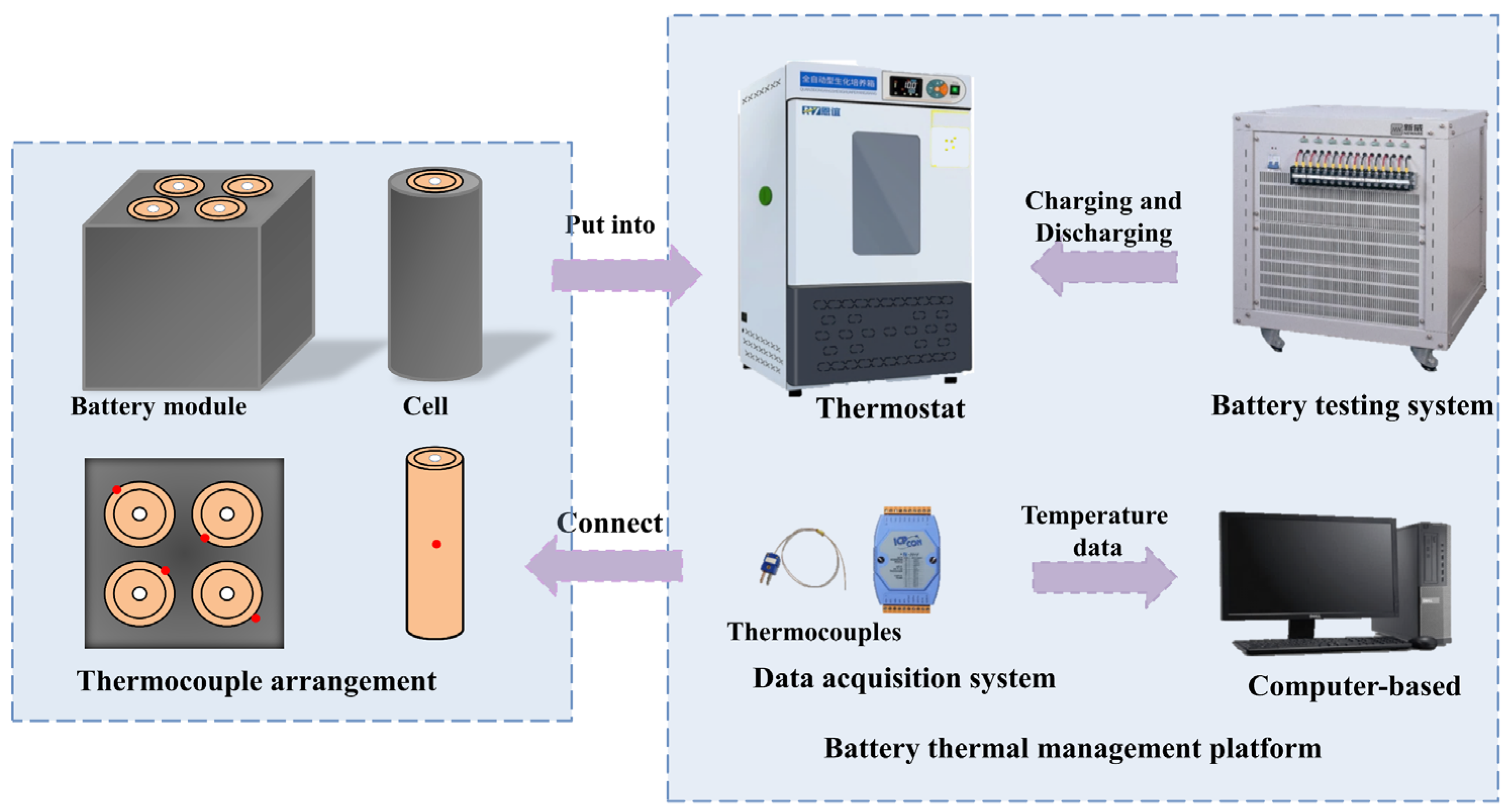

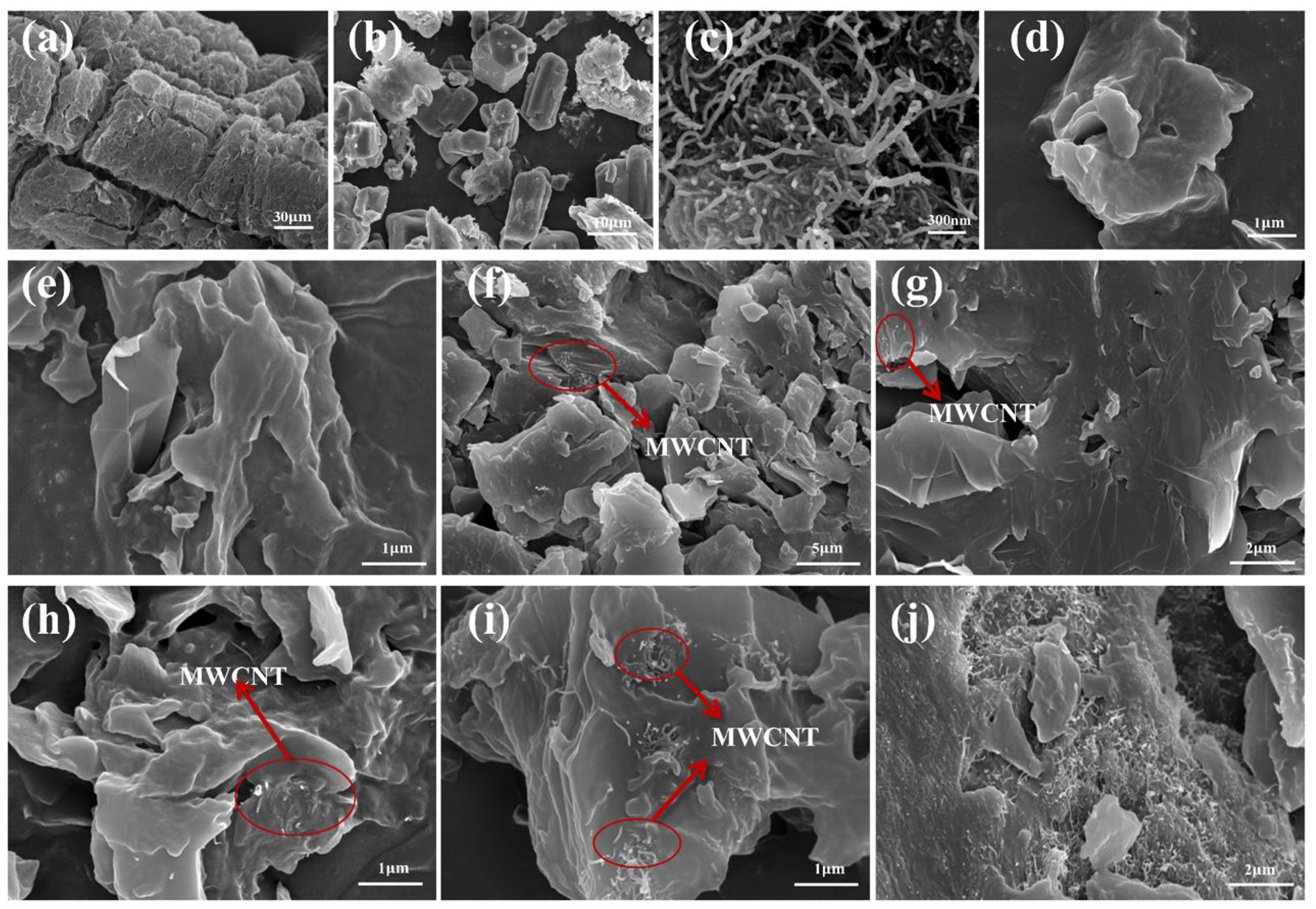
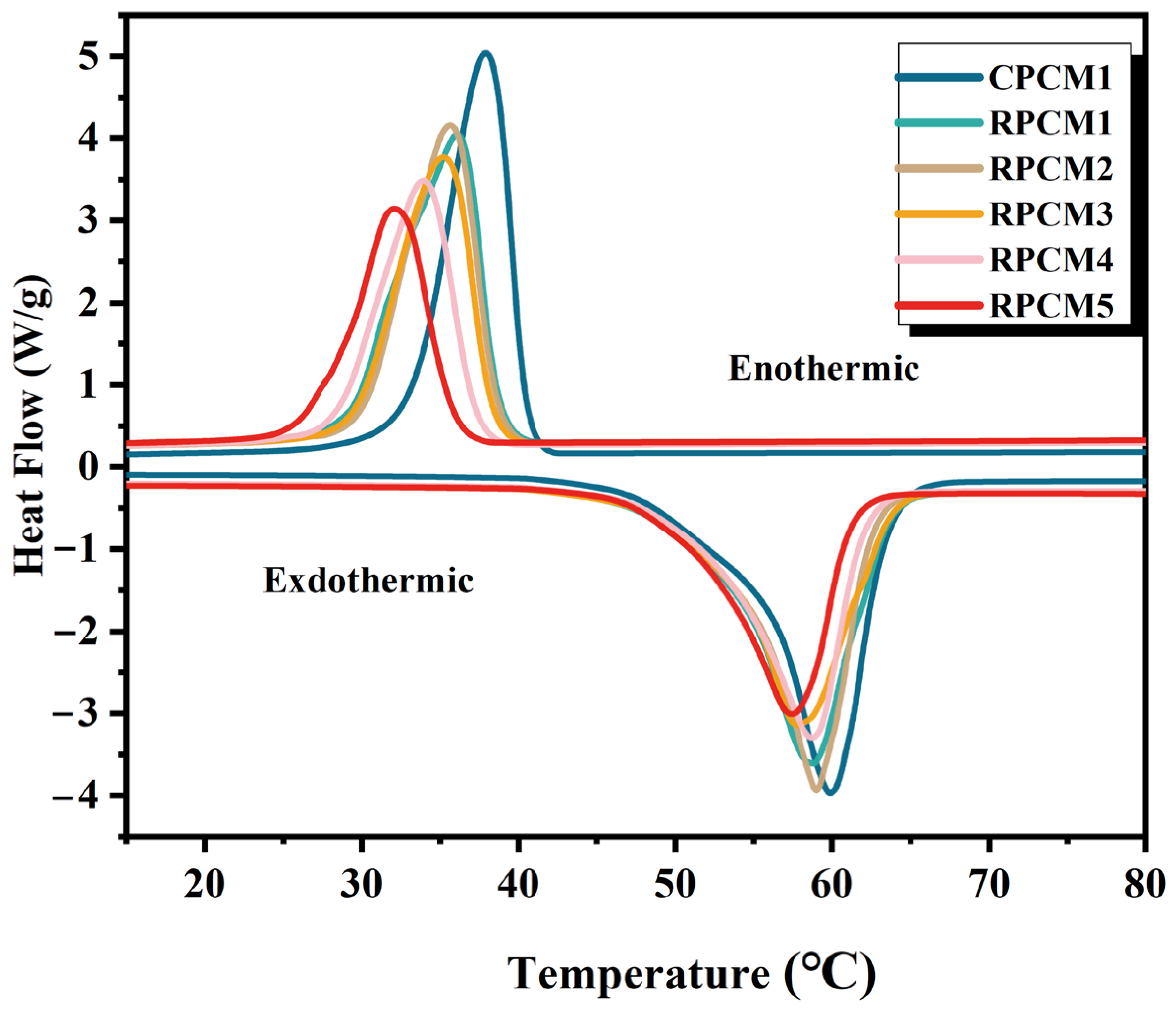
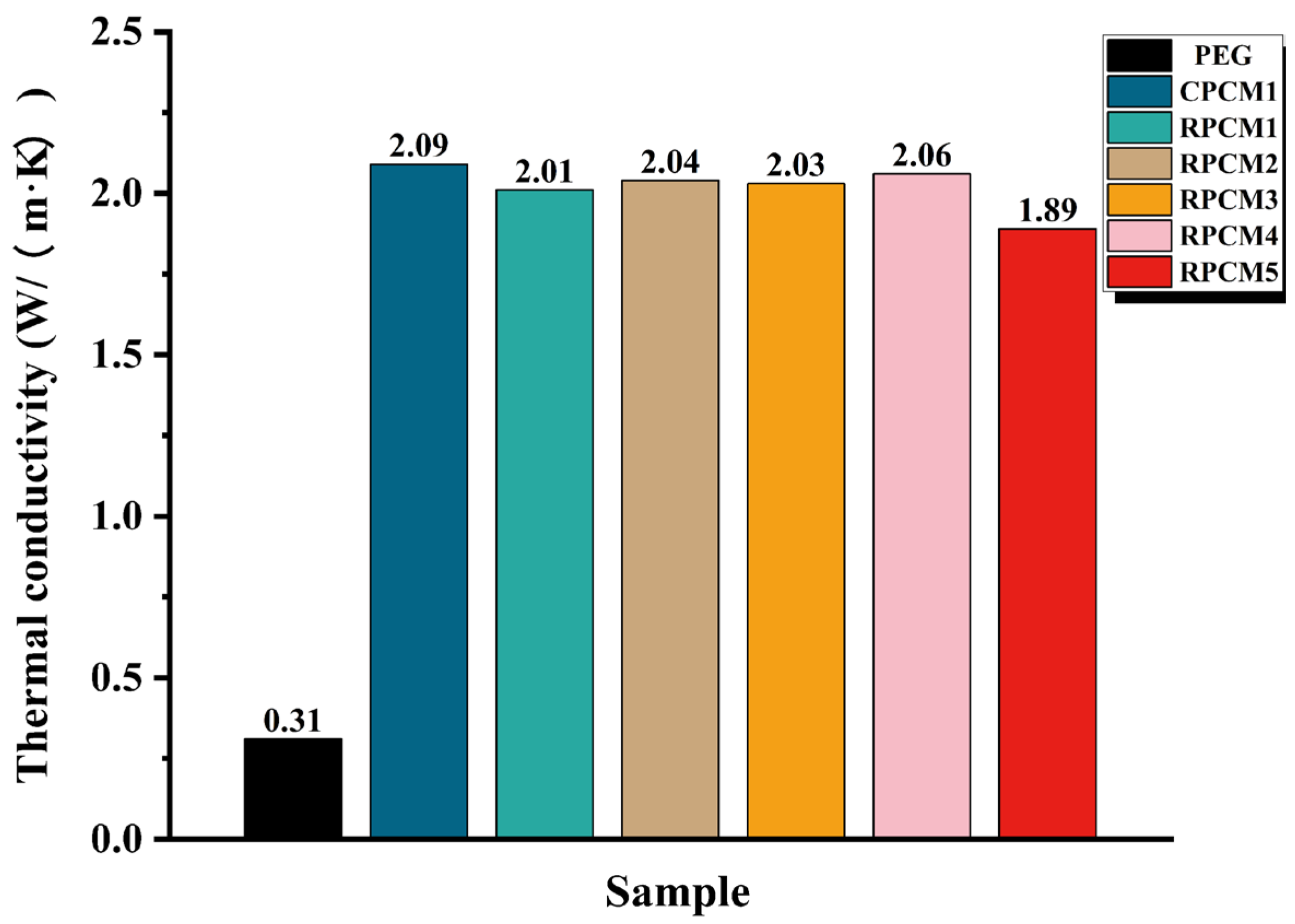


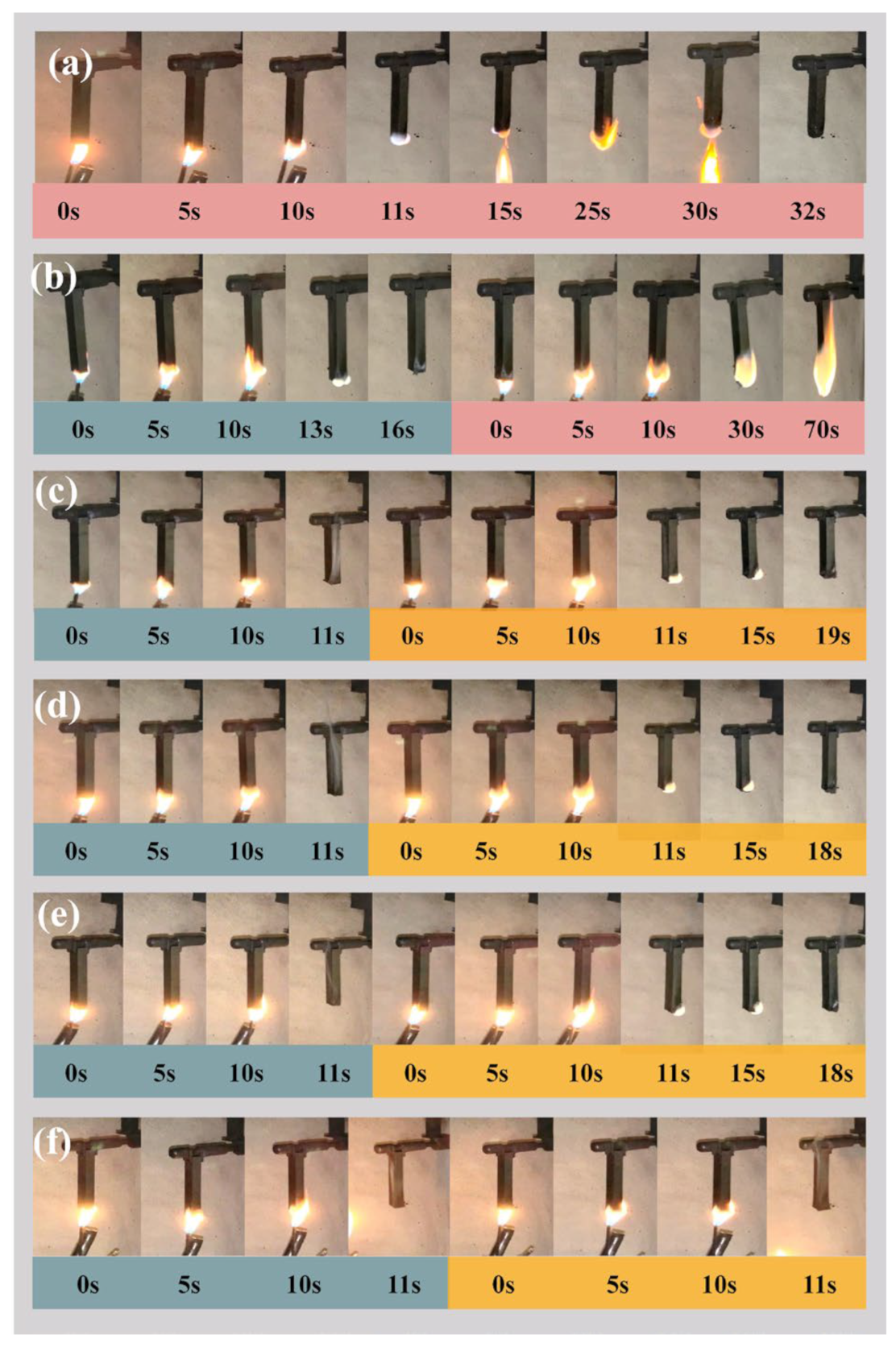
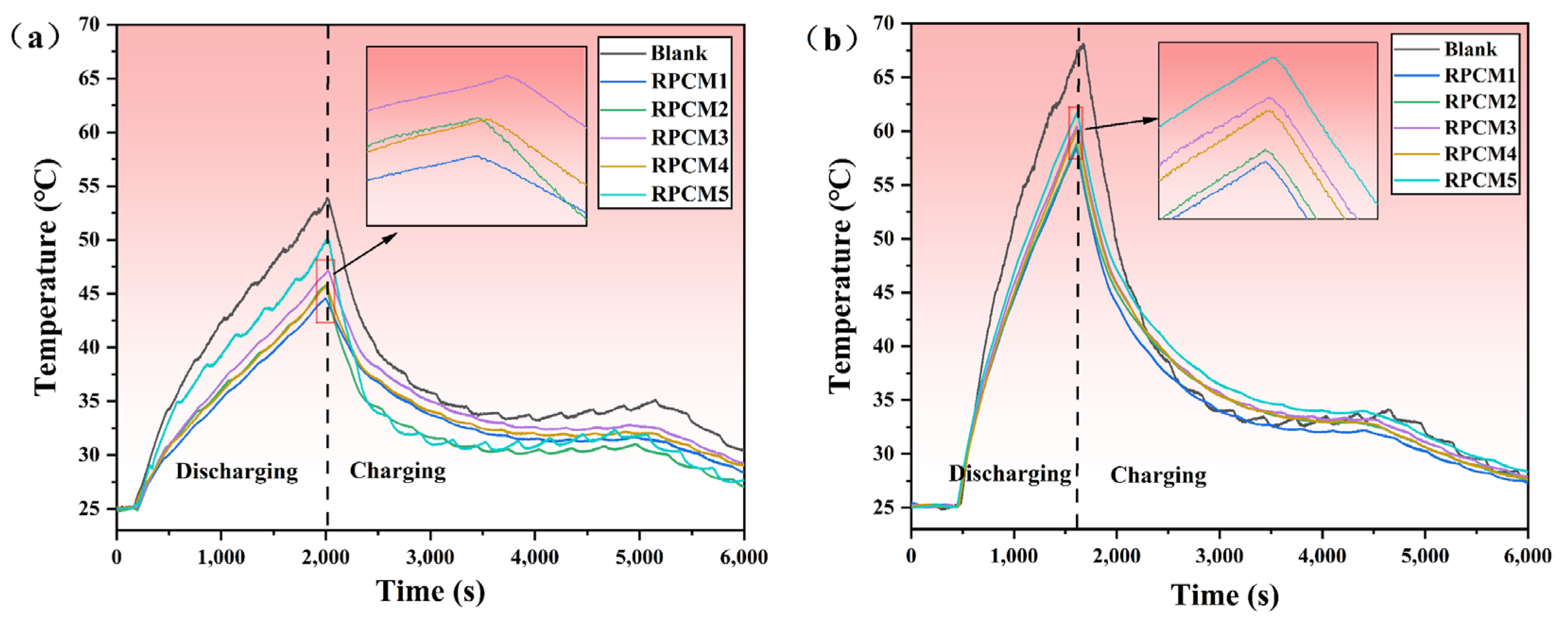
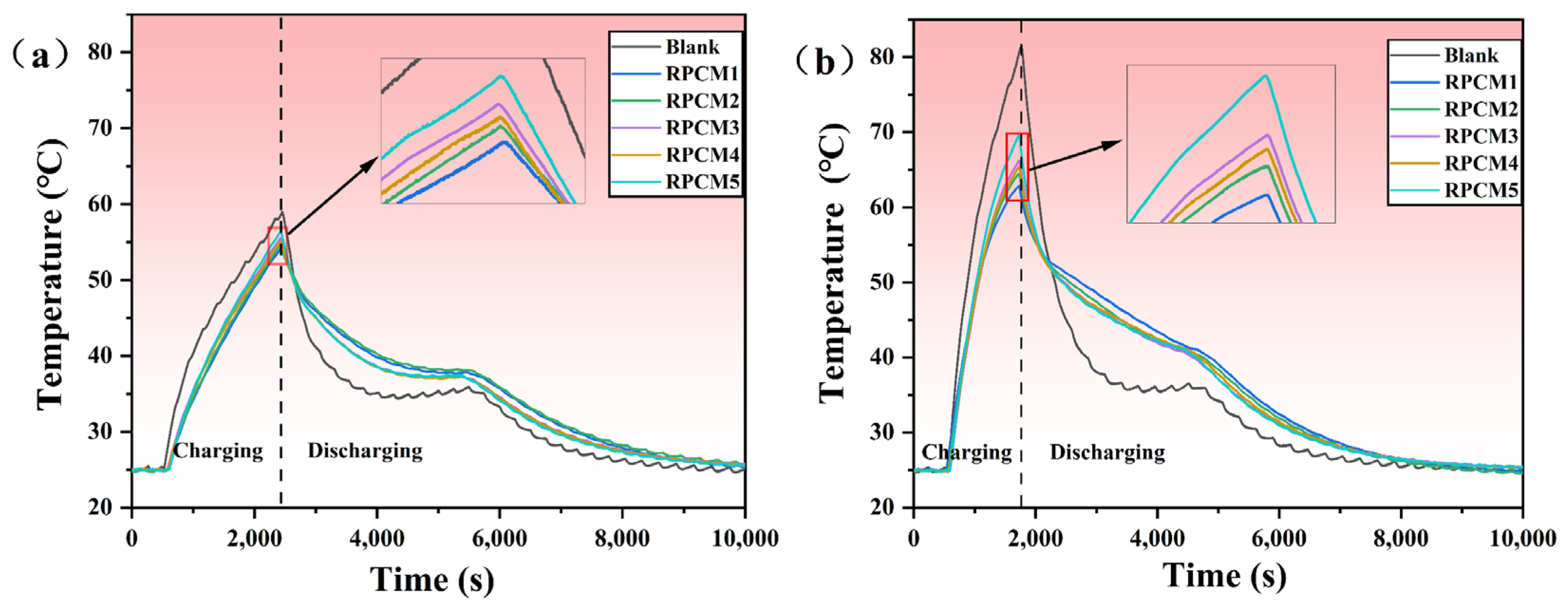
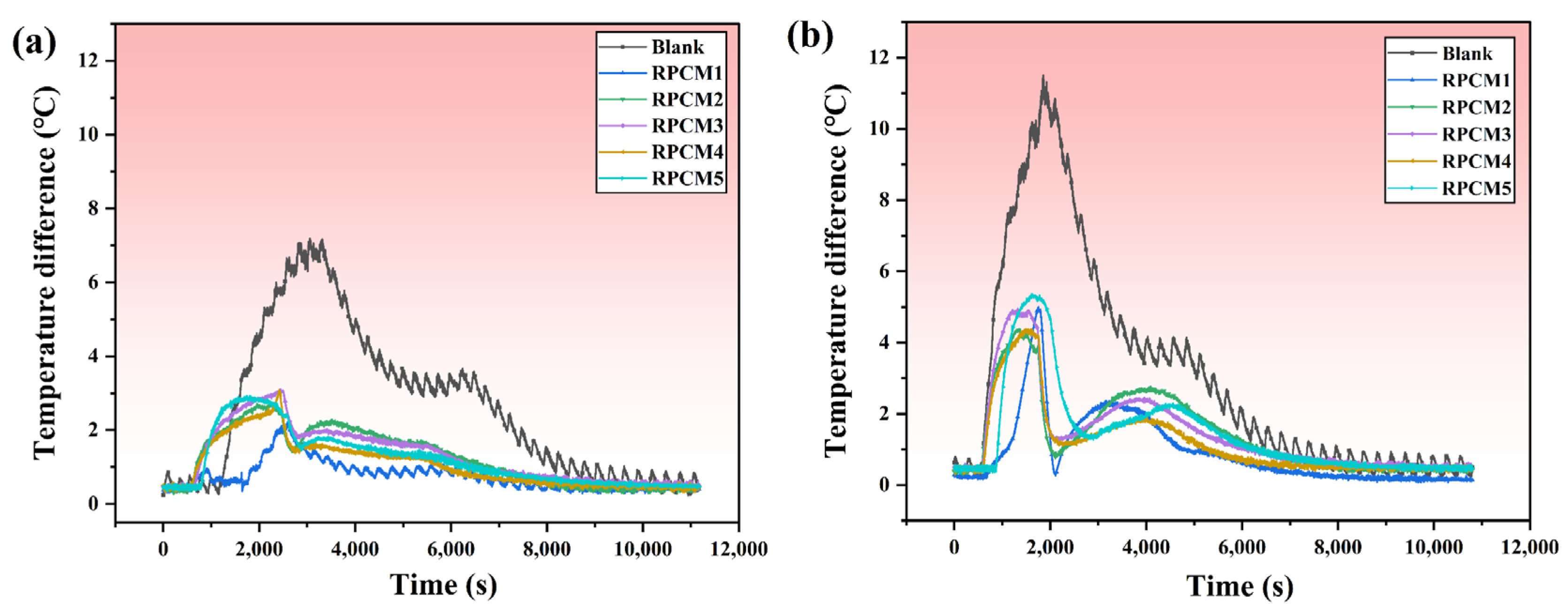
| Samples | PEG (wt%) | EG + MWCNT (wt%) | IFR (wt%) |
|---|---|---|---|
| CPCM1 | 93 | 5 + 2 | 0 |
| RPCM1 | 83 | 5 + 2 | 10 |
| RPCM2 | 78 | 5 + 2 | 15 |
| RPCM3 | 73 | 5 + 2 | 20 |
| RPCM4 | 68 | 5 + 2 | 25 |
| RPCM5 | 63 | 5 + 2 | 30 |
| Samples | (°C) | Latent Heat of Phase Change ΔH (w/g) |
|---|---|---|
| PEG | 57.32 | 183.73 |
| CPCM1 | 54.62 | 166.51 |
| RPCM1 | 52.89 | 157.55 |
| RPCM2 | 53.53 | 151.58 |
| RPCM3 | 52.93 | 141.24 |
| RPCM4 | 51.99 | 131.78 |
| RPCM5 | 51.09 | 119.45 |
| Samples | (°C) | (°C) |
|---|---|---|
| CPCM1 | 252.54 | 415.77 |
| RPCM1 | 375.59 | 429.78 |
| RPCM2 | 368.24 | 424.83 |
| RPCM3 | 362.19 | 388.20 |
| RPCM4 | 359.52 | 385.01 |
| RPCM5 | 350.76 | 385.56 |
| Samples | CPCM1 | RPCM1 | RPCM2 | RPCM3 | RPCM4 | RPCM5 |
|---|---|---|---|---|---|---|
| IFR (%) | 0 | 10 | 15 | 20 | 25 | 30 |
| UL-94 | / | / | V0 | V0 | V0 | V0 |
Disclaimer/Publisher’s Note: The statements, opinions and data contained in all publications are solely those of the individual author(s) and contributor(s) and not of MDPI and/or the editor(s). MDPI and/or the editor(s) disclaim responsibility for any injury to people or property resulting from any ideas, methods, instructions or products referred to in the content. |
© 2023 by the authors. Licensee MDPI, Basel, Switzerland. This article is an open access article distributed under the terms and conditions of the Creative Commons Attribution (CC BY) license (https://creativecommons.org/licenses/by/4.0/).
Share and Cite
Gong, Y.; Zhang, J.; Chen, Y.; Ouyang, D.; Chen, M. Application of Polyethylene Glycol-Based Flame-Retardant Phase Change Materials in the Thermal Management of Lithium-Ion Batteries. Polymers 2023, 15, 4450. https://doi.org/10.3390/polym15224450
Gong Y, Zhang J, Chen Y, Ouyang D, Chen M. Application of Polyethylene Glycol-Based Flame-Retardant Phase Change Materials in the Thermal Management of Lithium-Ion Batteries. Polymers. 2023; 15(22):4450. https://doi.org/10.3390/polym15224450
Chicago/Turabian StyleGong, Yan, Jiaxin Zhang, Yin Chen, Dongxu Ouyang, and Mingyi Chen. 2023. "Application of Polyethylene Glycol-Based Flame-Retardant Phase Change Materials in the Thermal Management of Lithium-Ion Batteries" Polymers 15, no. 22: 4450. https://doi.org/10.3390/polym15224450
APA StyleGong, Y., Zhang, J., Chen, Y., Ouyang, D., & Chen, M. (2023). Application of Polyethylene Glycol-Based Flame-Retardant Phase Change Materials in the Thermal Management of Lithium-Ion Batteries. Polymers, 15(22), 4450. https://doi.org/10.3390/polym15224450







